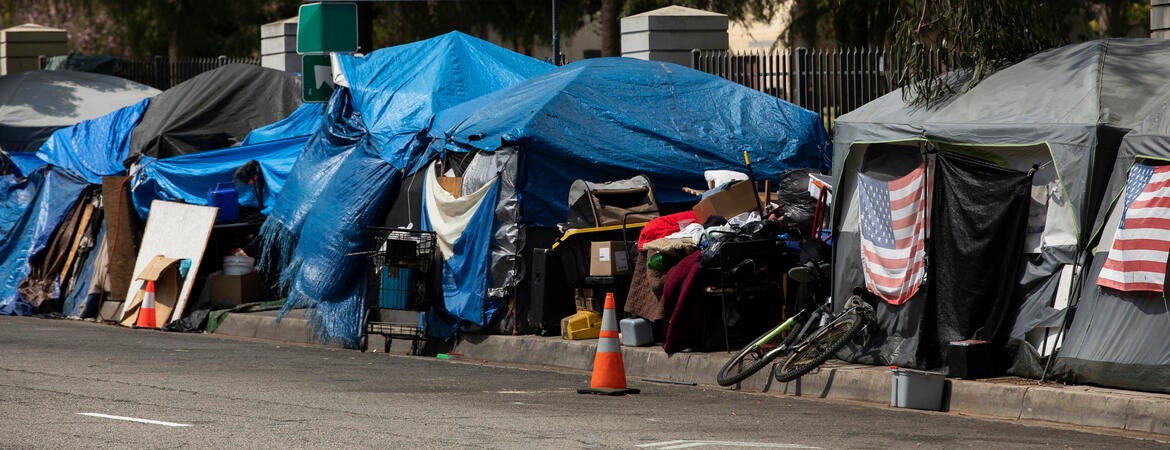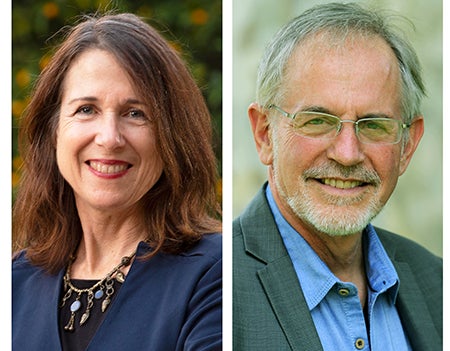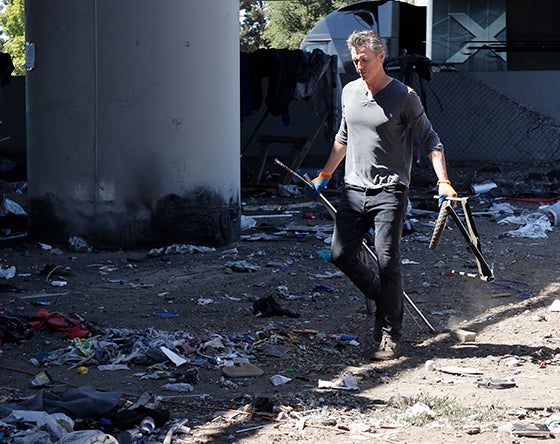
Gov. Gavin Newsom ordered California state officials on July 25 to begin dismantling thousands of homeless encampments, a move that’s expected to divide Democrats and impact the state’s 180,000 homeless residents. The action follows a recent Supreme Court ruling that gave governments greater authority to remove homeless people from their streets. We asked Professor of History Catherine Gudis and Distinguished Professor of Public Policy and Sociology Bruce Link to weigh in on Newsom’s order.
Q: Is Newsom’s action an effective way to deal with homelessness in California?
Gudis: No. Criminalizing the poor does not address poverty or homelessness. Without sufficient housing that is for extremely-low-to-no-income people and without services to support them in getting and keeping housing and healthcare, we will not make a dent in the current crisis. Clearing existing encampments worsens the chances of people to get housing, as it separates them from their belongings, case workers, and community networks. All it does is temporarily remove unhoused people from view. How is this anything but inhumane? And why would we entrust such actions to police and jails? This ruling is a travesty.
Q: Does Gov. Newsom’s action show that California’s homelessness crisis has worsened to the point where even liberal officials seek conservative solutions?
Link: My hunch is that it is less about the growing problem of unhoused people in California and more about the politics whirling around that problem that is motivating Newsom to move to a more conservative response.
Gudis: Unquestionably, this is a political move. Unfortunately, it would be unpopular on the right for Newsom to tell the truth: The marketplace has not and cannot solve this problem.
Q: Does Newsom’s action reflect the larger problems of an unsustainable economy in which housing prices have increased to the point where many members of the working class can’t afford a place to live?
Link: More than 45% of renters have to spend more than the recommended 30% of their incomes for housing -- 23% pay more than 50% of their incomes. This fundamental fact is one of the brutal circumstances lying beneath the pickle we see ourselves in with respect to encampments. A lost job, medical emergency, broken relationships, or even a car breakdown can push a fragile, barelycan-make-it rental arrangement into a tragedy. Decamping the camps, reclaiming the grocery carts and all the rest that this policy will achieve won’t touch the fundamental fact of housing insecurity in our state and beyond.
Gudis: I agree with Bruce Link 100%. Housing precarity is real. Hey, it’s on our campus and not just some place “out there.” Also, there are a range of reasons for people to camp. In turn, we need a range of approaches, a whole lot more caseworkers, and a whole lot more types of housing. It is really complicated and takes a lot of time to help people get anything more than temporary shelter.
Q: Newsom’s order requires state officials to work with groups and agencies that provide services, such as safe shelters and support, for unhoused people. If such services are available, why is there such a problem with encampments?
Link: I hate (sort of) to sound like a French philosopher but “the question returns to answer itself.” Call me suspicious but my hunch is that someone wants to seem to be acting humanely when in fact they are not.
Q: Won’t clearing encampments force many homeless people to set up new encampments elsewhere?
Gudis: I’m no mathematician, but if there aren’t enough beds to house all of the people experiencing homelessness, then new encampments are likely.
Q: Could Newsom’s action spur efforts to build a stronger social safety net in California, such as providing more shelters for the homeless, increasing unemployment benefits, bolstering job training, and improved access to health?
Link: In public policy and the social sciences, we worry a lot about unintended consequences. Will some unanticipated set of circumstances unravel our good intentions? The question posed above asks us to pray for unintended consequences — to hope that something good might emerge from this ill-advised adventure. Maybe it will, but… you have a better chance of making good things happen if you actually try to make them happen.
Gudis: All of those elements of a stronger safety net should be in place first. I don’t see how bulldozing encampments and offering temporary shelter or incarceration will create any such mechanisms, or where people are supposed to wait it out. If the governor was really concerned about the health and safety of people in and around encampments, he would be bringing together leaders who have been working at street level to create respite centers in neighborhoods, with healthcare, social workers, job training, and hygiene (bathrooms, showers, washing machines) to build pathways to successful permanent housing placement. Wisely, LA County’s Board of Supervisors has decided not to honor Newsom’s directives, to keep pushing forward with a care-first model. Hopefully others will follow suit.





